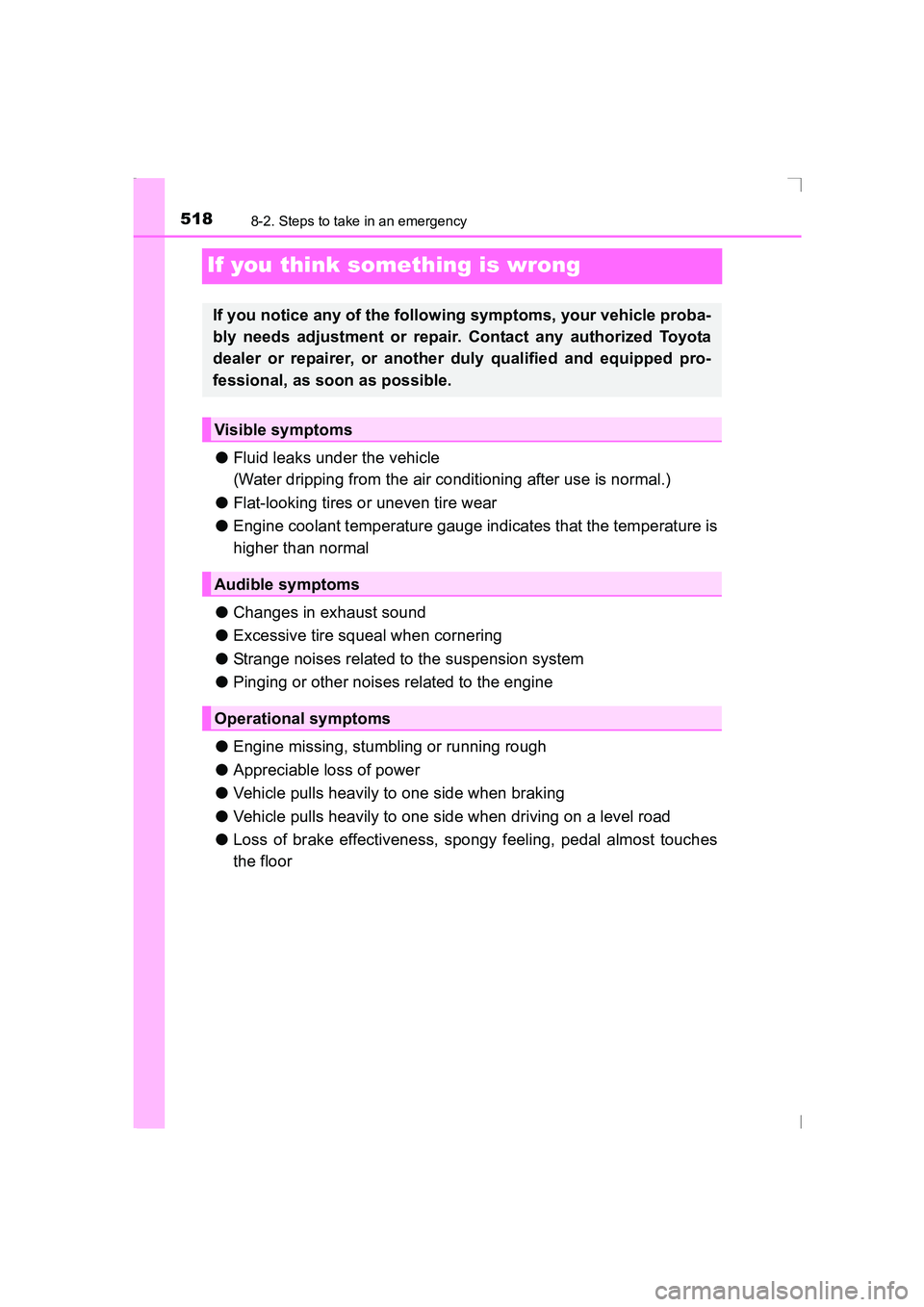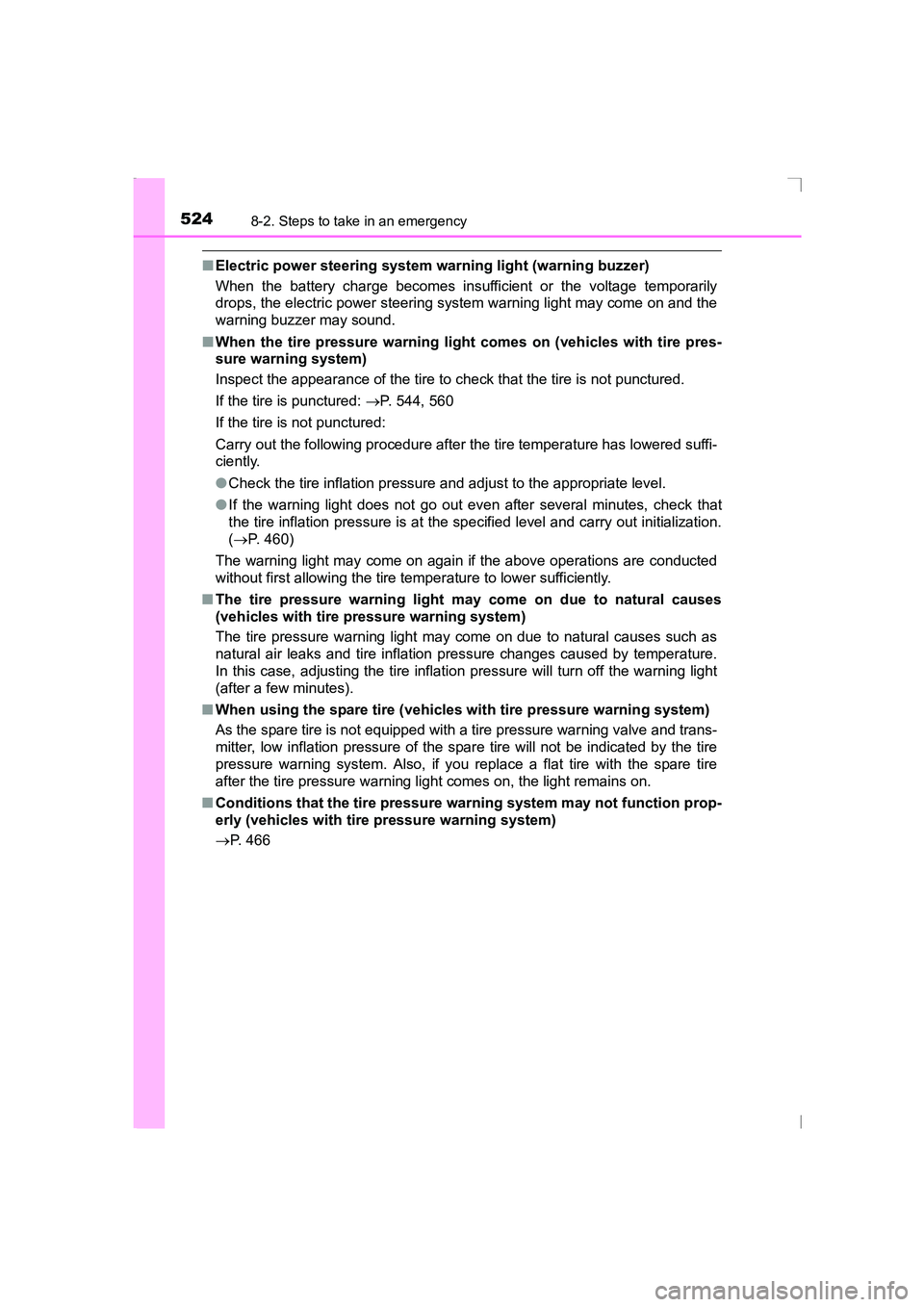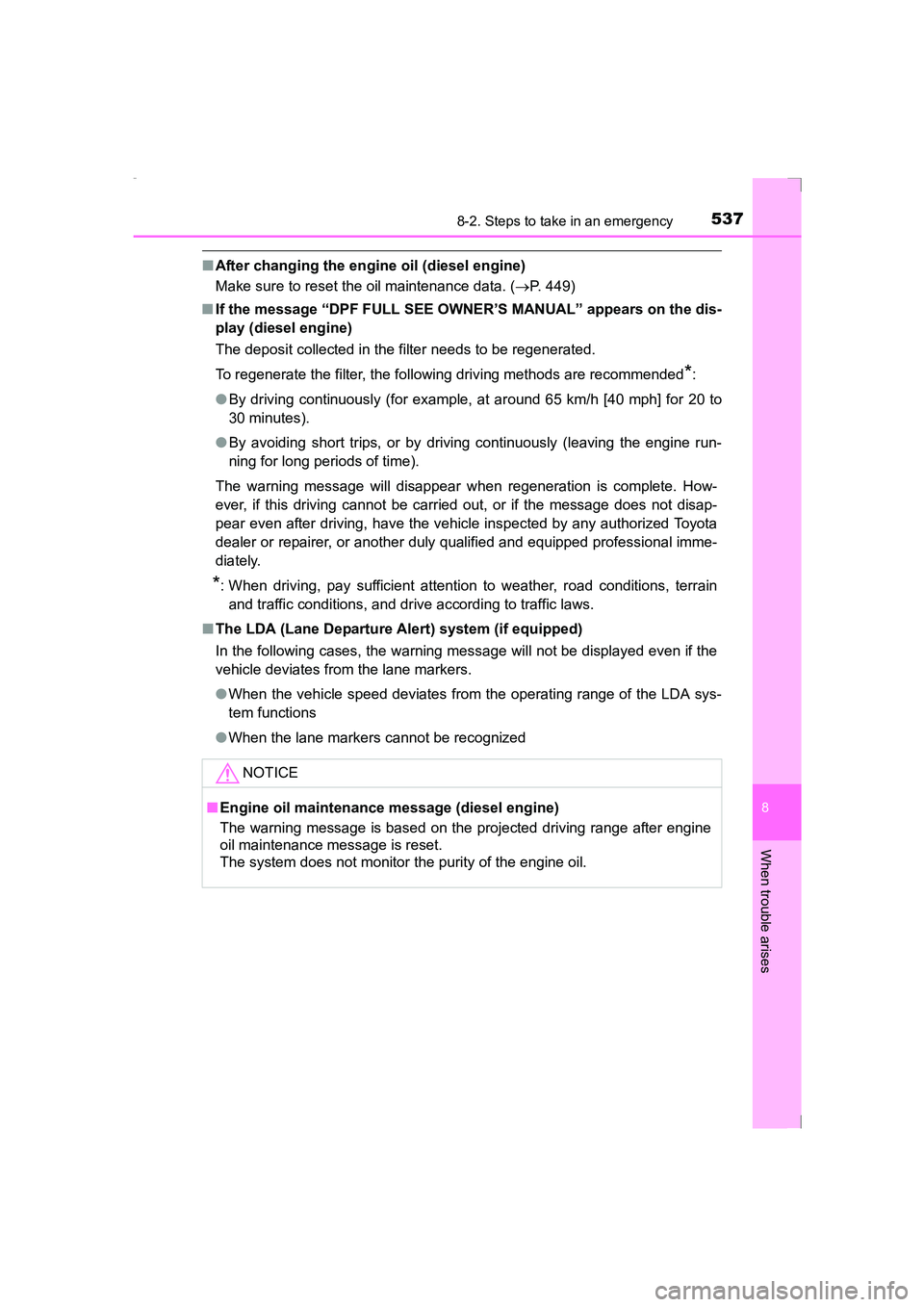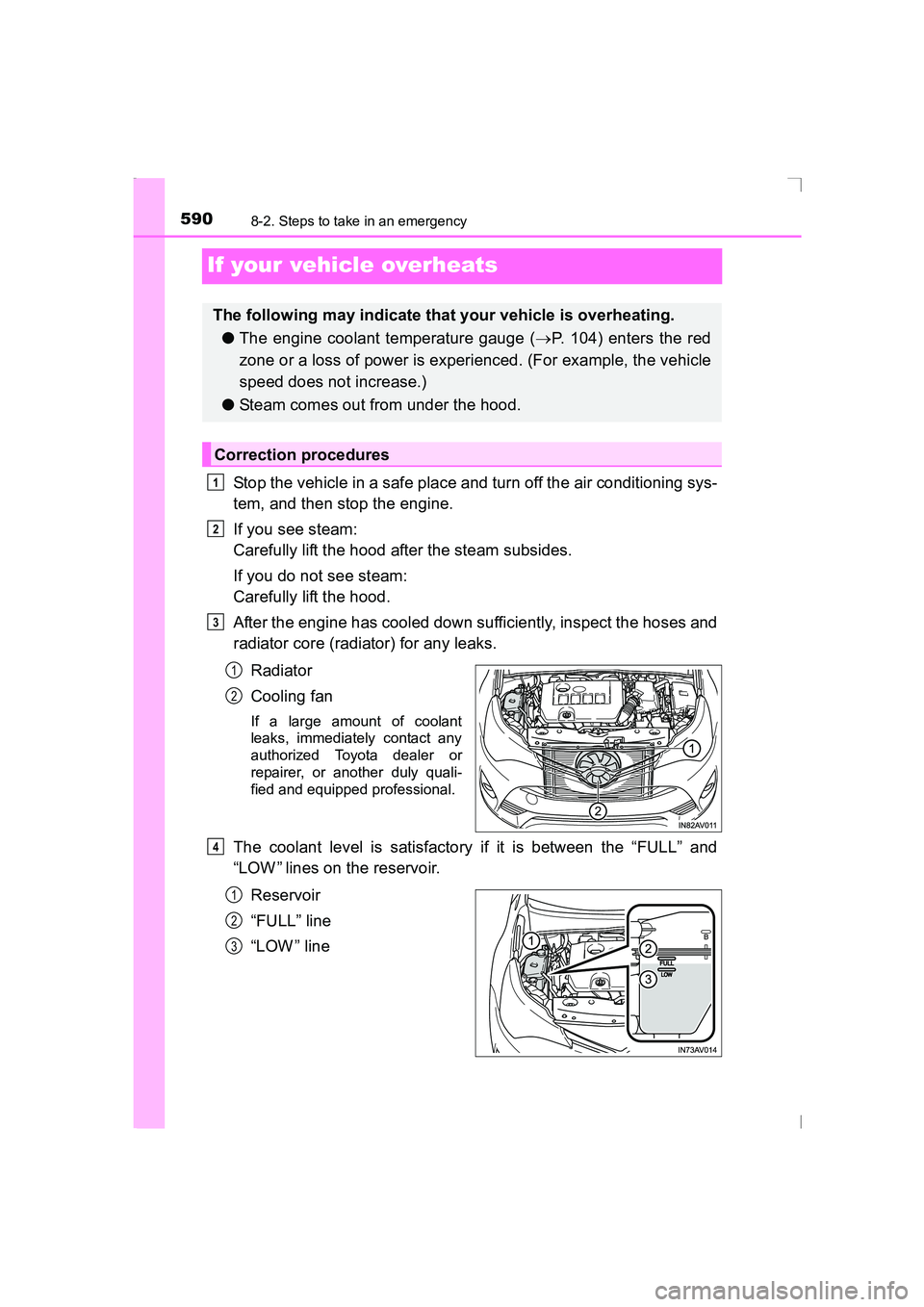Page 481 of 648
4817-3. Do-it-yourself maintenance
AVENSIS_OM_OM20C20E_(EE)
7
Maintenance and care
Remove the filter cover.
Remove the air conditioning fil-
ter and replace it with a new
one.
The “↑UP” marks shown on the fil-
ter should be pointing up.
■ Checking interval
Inspect and replace the air conditioning filter according to the maintenance
schedule. In dusty areas or areas with heavy traffic flow, early replacement
may be required. (For scheduled maintenance information, please refer to the
“Toyota Service Booklet” or “Toyota Warranty Booklet”.)
■ If air flow from the vents decreases dramatically
The filter may be clogged. Check the filter and replace if necessary.
4
�XLeft-hand drive vehicles�XRight-hand drive vehicles
5
NOTICE
■When using the air conditioning system
Make sure that a filter is always installed.
Using the air conditi oning system without a filter may cause damage to the
system.
AVENSIS_OM_OM20C20E_(EE).book Page 481 Thursday, January 29, 2015 1:47 PM
Page 518 of 648

5188-2. Steps to take in an emergency
AVENSIS_OM_OM20C20E_(EE)
If you think something is wrong
●Fluid leaks under the vehicle
(Water dripping from the air conditioning after use is normal.)
● Flat-looking tires or uneven tire wear
● Engine coolant temperature gauge indicates that the temperature is
higher than normal
● Changes in exhaust sound
● Excessive tire squeal when cornering
● Strange noises related to the suspension system
● Pinging or other noises related to the engine
● Engine missing, stumbling or running rough
● Appreciable loss of power
● Vehicle pulls heavily to one side when braking
● Vehicle pulls heavily to one side when driving on a level road
● Loss of brake effectiveness, spongy feeling, pedal almost touches
the floor
If you notice any of the following symptoms, your vehicle proba-
bly needs adjustment or repair. Contact any authorized Toyota
dealer or repairer, or another duly qualified and equipped pro-
fessional, as soon as possible.
Visible symptoms
Audible symptoms
Operational symptoms
AVENSIS_OM_OM20C20E_(EE).book Page 518 Thursday, January 29, 2015 1:47 PM
Page 524 of 648

5248-2. Steps to take in an emergency
AVENSIS_OM_OM20C20E_(EE)
■Electric power steering system warning light (warning buzzer)
When the battery charge becomes insufficient or the voltage temporarily
drops, the electric power steering system warning light may come on and the
warning buzzer may sound.
■ When the tire pressure warning light comes on (vehicles with tire pres-
sure warning system)
Inspect the appearance of the tire to check that the tire is not punctured.
If the tire is punctured: →P. 544, 560
If the tire is not punctured:
Carry out the following procedure after the tire temperature has lowered suffi-
ciently.
● Check the tire inflation pressure and adjust to the appropriate level.
● If the warning light does not go out even after several minutes, check that
the tire inflation pressure is at the specified level and carry out initialization.
(→ P. 460)
The warning light may come on again if the above operations are conducted
without first allowing the tire temperature to lower sufficiently.
■ The tire pressure warning light may come on due to natural causes
(vehicles with tire pressure warning system)
The tire pressure warning light may come on due to natural causes such as
natural air leaks and tire inflation pressure changes caused by temperature.
In this case, adjusting the tire inflation pressure will turn off the warning light
(after a few minutes).
■ When using the spare tire (vehicles with tire pressure warning system)
As the spare tire is not equipped with a tire pressure warning valve and trans-
mitter, low inflation pressure of the spare tire will not be indicated by the tire
pressure warning system. Also, if you r eplace a flat tire with the spare tire
after the tire pressure warning light comes on, the light remains on.
■ Conditions that the tire pressure warning system may not function prop-
erly (vehicles with tire pressure warning system)
→ P. 466
AVENSIS_OM_OM20C20E_(EE).book Page 524 Thursday, January 29, 2015 1:47 PM
Page 537 of 648

5378-2. Steps to take in an emergency
AVENSIS_OM_OM20C20E_(EE)
8
When trouble arises
■After changing the engine oil (diesel engine)
Make sure to reset the oil maintenance data. ( →P. 449)
■ If the message “DPF FULL SEE OWNER’S MANUAL” appears on the dis-
play (diesel engine)
The deposit collected in the filter needs to be regenerated.
To regenerate the filter, the following driving methods are recommended
*:
● By driving continuously (for example, at around 65 km/h [40 mph] for 20 to
30 minutes).
● By avoiding short trips, or by driv ing continuously (leaving the engine run-
ning for long periods of time).
The warning message will disappear w hen regeneration is complete. How-
ever, if this driving cannot be carried out, or if the message does not disap-
pear even after driving, have the vehicle inspected by any authorized Toyota
dealer or repairer, or another duly qualified and equipped professional imme-
diately.
*: When driving, pay sufficient attention to weather, road conditions, terrain and traffic conditions, and drive according to traffic laws.
■ The LDA (Lane Departure Alert) system (if equipped)
In the following cases, the warning message will not be displayed even if the
vehicle deviates from the lane markers.
●When the vehicle speed deviates from the operating range of the LDA sys-
tem functions
● When the lane markers cannot be recognized
NOTICE
■Engine oil maintenance message (diesel engine)
The warning message is based on the projected driving range after engine
oil maintenance message is reset.
The system does not monitor the purity of the engine oil.
AVENSIS_OM_OM20C20E_(EE).book Page 537 Thursday, January 29, 2015 1:47 PM
Page 573 of 648

5738-2. Steps to take in an emergency
AVENSIS_OM_OM20C20E_(EE)
8
When trouble arises
WARNING
■ When fixing the flat tire
●After inflation of the tire has completed, the sealant may splatter when the
hose is disconnected or some air is let out of the tire.
● Follow the operation procedure to repair the tire. If the procedures not fol-
lowed, the sealant may spray out.
● Keep back from the tire while it is being repaired, as there is a chance of it
bursting while the repair operation is being performed. If you notice any
cracks or deformation of the tire, turn off the compressor switch and stop
the repair operation immediately.
● The repair kit may overheat if operated for a long period of time. Do not
operate the repair kit continuously for more than 40 minutes.
● Parts of the repair kit become hot during operation. Be careful when han-
dling the repair kit during and after operation. Do not touch the metal part
around the connecting area between the bottle and compressor. It will be
extremely hot.
● Do not attach the vehicle speed warning sticker to an area other than the
one indicated. If the sticker is attached to an area where an SRS airbag is
located, such as the pad of the steering wheel, it may prevent the SRS air-
bag from operating properly.
■ Driving to spread the liquid sealant evenly
Observe the following precautions to reduce the risk of accidents.
Failing to do so may result in a loss of vehicle control and cause death or
serious injury.
●Drive the vehicle carefully at a low speed. Be especially careful when turn-
ing and cornering.
● If the vehicle does not drive straight or you feel a pull through the steering
wheel, stop the vehicle and check the following:
• Tire condition. The tire may have separated from the wheel.
• Tire inflation pressure. If the tire inflation pressure is 130 kPa (1.3 kgf/cm
2
or bar, 19 psi) or less, the tire may be severely damaged.
AVENSIS_OM_OM20C20E_(EE).book Page 573 Thursday, January 29, 2015 1:47 PM
Page 590 of 648

5908-2. Steps to take in an emergency
AVENSIS_OM_OM20C20E_(EE)
If your vehicle overheats
Stop the vehicle in a safe place and turn off the air conditioning sys-
tem, and then stop the engine.
If you see steam:
Carefully lift the hood after the steam subsides.
If you do not see steam:
Carefully lift the hood.
After the engine has cooled down sufficiently, inspect the hoses and
radiator core (radiator) for any leaks.Radiator
Cooling fan
If a large amount of coolant
leaks, immediately contact any
authorized Toyota dealer or
repairer, or another duly quali-
fied and equipped professional.
The coolant level is satisfactory if it is between the “FULL” and
“LOW ” lines on the reservoir.Reservoir
“FULL” line
“LOW ” line
The following may indicate that your vehicle is overheating.● The engine coolant temperature gauge ( →P. 104) enters the red
zone or a loss of power is experienced. (For example, the vehicle
speed does not increase.)
● Steam comes out from under the hood.
Correction procedures
1
2
3
1
2
4
1
2
3
AVENSIS_OM_OM20C20E_(EE).book Page 590 Thursday, January 29, 2015 1:47 PM
Page 591 of 648

5918-2. Steps to take in an emergency
AVENSIS_OM_OM20C20E_(EE)
8
When trouble arises
Add coolant if necessary.
Water can be used in an emer-
gency if coolant is unavailable.
Start the engine and turn the air conditioning system on to check
that the radiator cooling fan operates and to check for coolant leaks
from the radiator or hoses.
The fan operates when the air conditioning system is turned on immedi-
ately after a cold start. Confirm that the fan is operating by checking the fan
sound and air flow. If it is difficult to check these, turn the air conditioning
system on and off repeatedly.
(The fan may not operate in freezing temperatures.)
If the fan is not operating:
Stop the engine immediately and contact any authorized Toyota
dealer or repairer, or another duly qualified and equipped profes-
sional.
If the fan is operating:
Have the vehicle inspected at the nearest authorized Toyota dealer
or repairer, or another duly qualified and equipped professional.
5
WARNING
■ To prevent an accident or injury when inspecting under the hood of
your vehicle
●If steam is seen coming from under the hood, do not open the hood until
the steam has subsided. The engine compartment may be very hot, caus-
ing serious injury such as burns.
● Keep hands and clothing (especially a tie, a scarf or a muffler) away from
the fan and belts. Failure to do so may cause the hands or clothing to be
caught, resulting in serious injury.
● Do not loosen the coolant reservoir cap while the engine and radiator are
hot.
Serious injury, such as burns, may result from hot coolant and steam
released under pressure.
6
7
AVENSIS_OM_OM20C20E_(EE).book Page 591 Thursday, January 29, 2015 1:47 PM
Page 600 of 648
6009-1. Specifications
AVENSIS_OM_OM20C20E_(EE)
�XDiesel engine
Drive belt
tension1ZR-FAE7.6
10.0 mm (0.30 0.39 in.)
*
*
: Drive belt deflection with 98 N (10 kgf, 22 lbf) thumb force (used belt)
2ZR-FAE
3ZR-FAE Automatic adjustment
Crankshaft Generator
Water pump Air
conditioning
compressor
Model 1WW, 2WW
Type 4-cylinder in line, 4-cycle, diesel
Bore and stroke
�X1WW engine
78.0 × 83.6 mm (3.07 × 3.29 in.)
�X2WW engine
84.0 × 90.0 mm (3.31 × 3.54 in.)
Displacement
�X1WW engine
1598 cm
3 (97.52 cu. in.)
�X2WW engine
1995 cm
3 (121.74 cu.in.)
Valve clearance
(engine cold) Automatic adjustment
Drive belt tension Automatic adjustment
AVENSIS_OM_OM20C20E_(EE).book Page 600 Thursday, January 29,
2015 1:47 PM